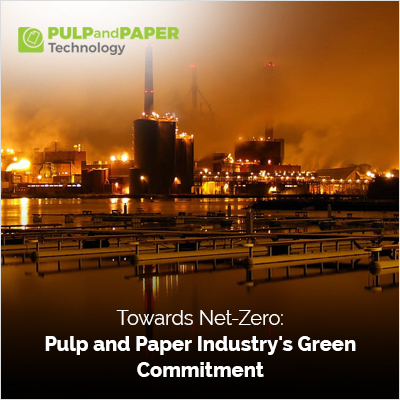Towards Net-Zero: Pulp and Paper Industry's Green Commitment

Introduction
In an era of increasing environmental concerns, the pulp and paper industry is taking significant strides toward achieving sustainability goals and embracing a green outlook. With a commitment towards net-zero emissions and a focus on minimizing carbon footprints, this vital industry is redefining its practices to align with the global climate agenda.
The shift towards sustainability in the pulp and paper industry comes as no surprise, considering its significant environmental impact. From deforestation to water pollution, the industry has long been scrutinized for its contribution to environmental degradation. However, industry leaders are now leading the charge in adopting innovative technologies and implementing responsible practices to address these concerns.
By investing in clean technologies, such as the utilization of renewable energy sources and reducing waste through responsible production methods, the industry is making significant progress towards achieving its green commitment. Furthermore, collaborations with stakeholders and implementing stringent environmental policies are also key factors influencing the industry’s sustainable transformation.
As a result of these concerted efforts, the pulp and paper industry is not only reducing its environmental impact but also aligning itself with the global movement towards a more sustainable and eco-friendly future. With a strong commitment to achieving net-zero emissions, the industry is playing a vital role in building a greener world for future generations.
Environmental Impact of the Pulp and Paper Industry
The pulp and paper industry has historically had a significant environmental impact, primarily due to its reliance on raw materials derived from forests. Deforestation, a direct consequence of the industry's need for wood fibers, has led to the destruction of natural habitats and loss of biodiversity. Additionally, the manufacturing processes involved in producing paper contribute to air and water pollution, as well as the release of greenhouse gases.
However, in recent years, the industry has recognized the need to address these issues and has taken steps to mitigate its environmental impact. Through sustainable forestry practices, responsible sourcing of raw materials, and the adoption of cleaner production methods, the industry aims to minimize its ecological footprint.
Understanding Net-Zero Emissions
Net-zero emissions refer to the achievement of a balance between the amount of greenhouse gases emitted into the atmosphere and the amount removed or offset. This balance is crucial to prevent further global warming and mitigate the effects of climate change. To achieve net-zero emissions, industries must reduce their greenhouse gas emissions as much as possible and then offset any remaining emissions through various means, such as carbon sequestration or the use of carbon credits.
For the pulp and paper industry, achieving net-zero emissions entails reducing emissions from both direct and indirect sources. Direct emissions primarily come from the combustion of fossil fuels during the production process, while indirect emissions arise from activities such as transportation, waste management, and the use of electricity.
Global Efforts towards Net-Zero Emissions
The global community has recognized the urgency of addressing climate change and has set ambitious targets to achieve net-zero emissions. The Paris Agreement, signed by nearly all countries, aims to limit global warming to well below 2 degrees Celsius above pre-industrial levels and to pursue efforts to limit the temperature increase to 1.5 degrees Celsius.
To support these goals, governments, businesses, and industries around the world are implementing measures to reduce greenhouse gas emissions. The pulp and paper industry, being a significant contributor to emissions, has a crucial role to play in these efforts. By embracing sustainable practices and adopting clean technologies, the industry can contribute to decarbonizing the economy and transitioning to a low-carbon future.
Green Initiatives in the Pulp and Paper Industry
Sustainable Forestry Practices
Sustainable forestry practices are essential for the long-term viability of the pulp and paper industry. By responsibly managing forests and ensuring the regeneration of harvested trees, the industry can maintain a sustainable supply of raw materials. This involves adhering to certification standards such as the Forest Stewardship Council (FSC) and promoting reforestation efforts. Additionally, the industry is investing in research and development to improve the efficiency of wood fiber utilization and reduce the need for virgin fibers.
Transitioning to Renewable Energy Sources
The pulp and paper industry is actively transitioning to renewable energy sources to reduce its reliance on fossil fuels and decrease greenhouse gas emissions. Renewable energy options such as biomass, solar, and wind power are being harnessed to power manufacturing processes. This not only reduces carbon emissions but also improves energy efficiency and reduces operational costs.
Innovations in Paper Recycling and Waste Reduction
Efforts to reduce waste and promote paper recycling play a crucial role in the industry's sustainability journey. Advanced technologies are being employed to increase the recyclability of paper products and improve the efficiency of recycling processes. Additionally, waste reduction initiatives, such as implementing circular economy principles and minimizing water usage, are being embraced to further reduce the industry's environmental impact.
The Role of Government Regulations and Policies
Government regulations and policies play a significant role in driving the pulp and paper industry's green commitment. By implementing stringent environmental standards, governments can incentivize the adoption of sustainable practices and ensure compliance with emissions reduction targets. Additionally, policies that promote the use of recycled paper and support the development of clean technologies contribute to the industry's sustainability efforts.
Conclusion: The Future of the Pulp and Paper Industry's Green Commitment
The pulp and paper industry's journey towards achieving net-zero emissions and embracing sustainability is well underway. Through a combination of sustainable forestry practices, transitioning to renewable energy sources, innovations in paper recycling, and government support, the industry is making significant progress in reducing its environmental impact.
As the industry continues to evolve, collaboration between stakeholders, including governments, businesses, and consumers, will be crucial in driving further sustainability advancements. By working together, we can ensure a greener future, where the pulp and paper industry plays a vital role in building a sustainable and eco-friendly world for generations to come.









